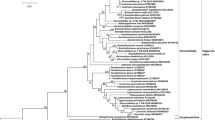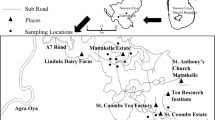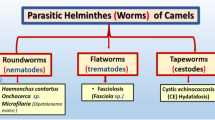Abstract
Physaloptera spp. are common nematodes found in the stomach and muscles of mammals, reptiles, amphibians, and birds. Physaloptera spp. have a complicated life cycle with multiple definitive hosts, arthropod intermediate hosts, aberrant infections, and possible second intermediate hosts or paratenic hosts. For example, Physaloptera sp. larvae have been found within the tissues of wild northern bobwhite quail (Colinus virginianus), and it is suspected that quail may serve as paratenic or secondary hosts of these parasites. However, because it is not known what role quail play in the life cycle of Physaloptera spp. and descriptions of Physaloptera spp. larvae are limited, molecular tools may be beneficial when identifying these helminths. In this study, we generated primers using universal nematode primers and obtained a partial mitochondrial cytochrome oxidase 1 (COX 1) sequence. Morphological identification of Physaloptera sp. in bobwhite was confirmed via polymerase chain reaction (PCR), and a phylogenetic tree was constructed using the maximum likelihood method. BLAST analysis revealed a strong identity to other Physaloptera spp. and the phylogenetic tree placed all Physaloptera spp. in the same cluster. We also documented a marked increase in Physaloptera infections in bobwhite from 2017 to 2018, and the similarity of these parasites to Onchocerca volvulus and Wuchereria bancrofti may give insight into the increased prevalence we observed. This study demonstrates the usefulness of molecular techniques to confirm the identity of species that may lack adequate descriptions and provides new insight for the diagnosis and potentially overlooked significance of Physaloptera sp. infections of bobwhite in the Rolling Plains ecoregion of Texas.



Similar content being viewed by others
References
Almas S, Gibson AG, Presley SM (2018) Molecular detection of Oxyspirura larvae in arthropod intermediate hosts. Parasitol Res 117:819–823
Alzaga V, Vicente J, Villanua D, Acevedo P, Casas F, Gortazar C (2008) Body condition and parasite intensity correlates with escape capacity in Iberian hares (Lepus granatensis). Behav Ecol Sociobiol 62:769–775
Anderson RC, Chabaud AG, Willmott S (2009) Keys to the nematode parasites of vertebrates: archival volume. CAB International, Wallingford
Applegate R, Gerhold RW Jr, Fenton H, Fischer JR (2017) Free-ranging, northern bobwhite submissions to the southeastern cooperative wildlife disease study (1982–2015). Proc Natl Quail Symp 8:85
Armstrong D (1993) History of opportunistic infection in the immunocompromised host. Clin Infect Dis 17:318–321
Boggs JF, Peoples AD, Lochmiller RL (1990) Occurence and pathology of Physalopterid larvae infections in bobwhite quail from western Oklahoma. Proc Okla Acad Sci 70:29–31
Bordes F, Morand S (2011) The impact of multiple infections on wild animal hosts: a review. Infect Ecol Epidemiol 1:7346. https://doi.org/10.3402/iee.v1i0.7346
Bruno A (2014) Survey for Trichomonas gallinae and assessment of helminth parasites in northern bobwhites from the Rolling Plains ecoregion. Thesis, Texas A&M University-Kingsville
Brym MZ, Henry C, Kendall RJ (2018) Elevated parasite burdens as a potential mechanism affecting northern bobwhite (Colinus virginianus) population dynamics in the Rolling Plains of West Texas. Parasitol Res 1–6
Cawthorn RJ, Anderson RC (1976) Development of Physaloptera maxillaris (Nematoda: Physalopteroidea) in skunk (Mephitis mephitis) and the role of paratenic and other hosts in its life cycle. Can J Zool 54:313–323
Cleeland LM, Reichard MV, Tito RY, Reinhard KJ, Lewis CM Jr (2013) Clarifying prehistoric parasitism from a complementary morphological and molecular approach. J Archaeol Sci 40:3060–3066
Cox FEG (2001) Concomitant infections, parasites and immune responses. Parasitol 122:23–38
Cram EB (1931) Recent findings in connection with parasites of game birds. Trans Am Game Conf 18:243–247
Dixon JM, Roberson JH (1967) Case report: aberrant larvae of Physaloptera sp. in a quail (Colinus virginianus). Avian Dis 11:41–44
Dunham NR, Peper ST, Downing C, Brake E, Rollins D, Kendall RJ (2017) Infection levels of the eyeworm Oxyspirura petrowi and caecal worm Aulonocephalus pennula in the northern bobwhite and scaled quail from the Rolling Plains of Texas. J Helminthol 91:569–577
Engelbrecht F, Oettl T, Herter U, Link C, Philipp D, Edeghere H, Kaliraj P, Enwezor F (2003) Analysis of Wuchereria bancrofti infections in a village community in northern Nigeria: increased prevalence in individuals infected with Onchocerca volvulus. Parasitol Int 52:13–20
Faulkner H, Turner J, Behnke J, Kamgno J, Rowlinson MC, Bradley JE, Boussinesq M (2005) Associations between filarial and gastrointestinal nematodes. Trans R Soc Trop Med Hyg 99:301–312
Fernando RJ, Fernando SSE, Leong ASY (2001) Tropical infectious diseases: epidemiology, investigation, diagnosis and management. Cambridge University Press
Genchi C, Kramer LH, Rivasi F (2011) Dirofilarial infections in Europe. Vector-Borne Zoonotic Dis 11:1307–1317. https://doi.org/10.1089/vbz.2010.0247
Goldberg SR, Bursey CR (1989) Physaloptera retusa (Nematoda, Physalopteridae) in naturally infected sagebrush lizards, Sceloporus graciosus (Iguanidae). J Wildl Dis 25:425–429
González CE, Hamann MI (2012) First report of nematode parasites of Physalaemus albonotatus (Steindachner, 1864) (Anura: Leiuperidae) from Corrientes, Argentina. Neotrop Helminthol 6:9–23
Henry C, Brym MZ, Kendall RJ (2017) Oxyspirura petrowi and Aulonocephalus pennula infection in wild northern bobwhite quail in the Rolling Plains Ecoregion, Texas: possible evidence of a die-off. Arch Parasitol 1:2
Henry C, Brym MZ, Kalyanasundaram A, Kendall RJ (2018) Molecular identification of potential intermediate hosts of Aulonocephalus pennula from the order Orthoptera. J Helminthol:1–6
Jackson AS (1969) Quail management handbook for West Texas Rolling Plains. Bulletin Number 48. Texas Parks and Wildlife Department, Austin
Johnson JL, Rollins D, Reyna KS (2012) What’s a quail worth? A longitudinal assessment of quail hunter demographics, attitudes, and spending habits in Texas. Proc Natl Quail Symp 7:294–299
Kalyanasundaram A, Blanchard KR, Kendall RJ (2017) Molecular identification and characterization of partial COX1 gene from caecal worm (Aulonocephalus pennula) in northern bobwhite (Colinus virginianus) from the Rolling Plains Ecoregion of Texas. Int J Parasitol Parasites Wildl 6:195–201
Kozak M, Wędrychowicz H (2010) The performance of a PCR assay for field studies on the prevalence of Fasciola hepatica infection in Galba truncatula intermediate host snails. Vet Parasitol 168:25–30
Larkin MA, Blackshields G, Brown NP, Chenna R, McGettigan PA, McWilliam H, Valentin F, Wallace IM, Wilm A, Lopez R, Thompson JD, Gibson TJ, Higgins DG (2007) Clustal W and Clustal X version 2.0. Bioinformatics 23:2947–2948
Lello J, Boag B, Hudson PJ (2005) The effect of single and concomitant pathogen infections on condition and fecundity of the wild rabbit (Oryctolagus cuniculus). Int J Parasitol 35:1509–1515
Mboera LE, Senkoro KP, Rumisha SF, Mayala BK, Shayo EH, Mlozi MR (2011) Plasmodium falciparum and helminth coinfections among schoolchildren in relation to agro-ecosystems in Mvomero District, Tanzania. Acta Trop 120:95–102
Mohamadain HS, Ammar KN (2012) Redescription of Physaloptera praeputialis von Linstow, 1889 (Nematoda: Spirurida) infecting stray cats (Felis catus Linnaeus, 1758) in Qena, Egypt and overview of the genus taxonomy. J Egypt Soc Parasitol 42:675–690
Morand S, Harvey PH (2000) Mammalian metabolism, longevity and parasite species richness. Proc R Soc Lond B Biol Sci 267:1999–2003
Morgan BB (1941) A summary of the Physalopterinae (Nematoda) of North America. Proc Helminthol Soc Wash 8:28–30
Mukherjee S, Mukherjee N, Saini P, Gayen P, Roy P, Babu SPS (2014) Molecular evidence on the occurrence of co-infection with Pichia guilliermondii and Wuchereria bancrofti in two filarial endemic districts of India. Infect Dis Poverty 3:13
Naem S, Asadi R (2013) Ultrastructural characterization of male and female Physaloptera rara (Spirurida: Physalopteridae): feline stomach worms. Parasitol Res 112:1983–1990
Naem S, Abbass Farshid A, Tanhai Marand V (2006) Pathological findings on natural infection with Physaloptera praeputialis in cats. Veterinarski Arhiv 76:315–321
Nicolaides NJ, Musgrave J, McGuckin D, Moorhouse DE (1977) Nematode larvae (Spirurida: Physalopteridae) causing infarction of the bowel in an infant. Pathology 9:129–135
Pence DB, Meinzer WP (1979) Helminth parasitism in the coyote, Canis latrans, from the Rolling Plains of Texas. Int J Parasitol 9:339–344
Peterson MJ (2007) Diseases and parasites of Texas quails. In: Brennan LA (ed) Texas quails: ecology and management. Texas A&M University Press, College Station, pp 89–114
Petri LH, Ameel DJ (1950) Studies on the life cycle of Physaloptera rara Hall and Wigdor, 1918, and Physaloptera praeputialis Linstow, 1889. J Parasitol 36:40
Poppert S, Hodapp M, Krueger A, Hegasy G, Niesen WD, Kern WV, Tannich E (2009) Dirofilaria repens infection and concomitant meningoencephalitis. Emerg Infect Dis 15:1844–1846
Prosser SW, Velarde-Aguilar MG, Leon-Regagnon V, Hebert PD (2013) Advancing nematode barcoding: a primer cocktail for the cytochrome c oxidase subunit I gene from vertebrate parasitic nematodes. Mol Ecol Resour 13:1108–1115
Rietveld E, Vetter JCM, Stilma JS (1987) Concurrent parasitic infections among patients with onchocerciasis and controls in Sierra Leone, West Africa. Doc Ophthalmol 67:25–32
Sałamatin R, Pavlikovska T, Sagach O, Nikolayenko S, Kornyushin V, Kharchenko V, Masny A, Cielecka D, Konieczna-Sałamatin J, Conn D, Golab E (2013) Human dirofilariasis due to Dirofilaria repens in Ukraine, an emergent zoonosis: epidemiological report of 1465 cases. Acta Parasitol 58:592–598
Schell S (1952) Studies on the life cycle of Physaloptera hispida Schell (Nematoda: Spiruroidea) a parasite of the cotton rat (Sigmodon hispidus littoralis Chapman). J Parasitol 38:462–447
Schmidt GD, Roberts LS (2009) Foundations of parasitology, 8th edn. McGraw Hill, New York
Schrader C, Schielke A, Ellerbroek L, Johne R (2012) PCR inhibitors–occurrence, properties and removal. J Appl Microbiol 113:1014–1026
Soulsby EJL (1965) Textbook of veterinary clinical parasitology, volume 1: helminths. Blackwell, Oxford
Taton-Allen G, Cheney J (2001) Gastrointestinal parasites. In: Lappin MR (ed) Feline internal medicine secrets. Hanley & Belfus, Inc, Philadelphia, pp 85–95
Telfer S, Lambin X, Birtles R, Beldomenico P, Burthe S, Paterson S, Begon M (2010) Species interactions in a parasite community drive infection risk in a wildlife population. Sci 330:243–246
Telford SR Jr (1970) A comparative study of endoparasitism among some southern California lizard populations. Am Midl Nat 83:516–554
Velikanov VP, Sharpillo VP (2002) Experimental indentification of Physaloptera praeputialis, p 25–29
Wanji S, Tendongfor N, Esum M, Ndindeng S, Enyong P (2003) Epidemiology of concomitant infections due to Loa loa, Mansonella perstans, and Onchocerca volvulus in rain forest villages of Cameroon. Med Microbiol Immunol 192:15–21
Widmer EA (1970) Development of third-stage Physaloptera larvae from Crotalus viridis rafinesque, 1818 in cats with notes on pathology of the larvae in the reptile. (Nematoda, Spiruroidea). J Wildl Dis 6:89–93
Acknowledgements
We extend our gratitude to the owners and employees at our study ranch for their continued hospitality and for granting us ranch access. We also thank all the Wildlife Toxicology Laboratory (WTL) personnel for their laboratory and field assistance. Finally, we appreciate the dedication and help of the hunters that donate bobwhite to the WTL; their continued involvement is instrumental in advancing this research.
Funding
This research received funding and support from Park Cities Quail and the Rolling Plains Quail Research Foundation.
Author information
Authors and Affiliations
Corresponding author
Ethics declarations
All bobwhite were handled according to Texas Parks and Wildlife Research Permit No. SPR-0715-095 and Texas Tech Animal Care and Use Committee protocol 16071-08.
Conflict of interest
The authors declare that they have no conflict of interest.
Rights and permissions
About this article
Cite this article
Kalyanasundaram, A., Henry, C., Brym, M.Z. et al. Molecular identification of Physaloptera sp. from wild northern bobwhite (Colinus virginianus) in the Rolling Plains ecoregion of Texas. Parasitol Res 117, 2963–2969 (2018). https://doi.org/10.1007/s00436-018-5993-5
Received:
Accepted:
Published:
Issue Date:
DOI: https://doi.org/10.1007/s00436-018-5993-5




